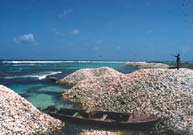Conch conquered?
At the size and weight of a bowling ball, and armoured with a tough spiky shell, the adult queen conch is a true heavyweight of the snail world - but this unique marine organism is far more fragile than it appears. Caribbean conch populations have seriously declined over the past two decades, due to the pollution of their seagrass ecosystem home and over-fishing - conch are highly prized for their delicious meat and beautiful shell. A competitor of the queen conch, the sea urchin, has benefitted greatly from our environmental meddling. In many areas, urchins have blossomed into an ecologically dominant species that may threaten the survival of queen conches through a monopolization of their food resources. Recent research suggests that halting this double-whammy assault on conch may do little to assist in their recovery.

Biologist Alex Tewfik
Claudio Calligaris
"A pristine seagrass ecosystem contains a wealth of biodiversity," explained Alex Tewfik, a biology PhD student who specializes in marine and community ecology. Tewfik will be finishing his thesis on natural and anthropogenic disturbances of seagrass meadows, mostly supervised by biologist Kevin McCann (now at University of Guelph) and currently overseen by McGill biologist Frederic Guichard. This multitude of life can coexist in an unspoilt environment, even though some species compete for the same food resources as do the sea urchin and the queen conch. Trouble occurs when humans become involved. "Through fishing and pollution, we can bias competitive relationships and upset the natural balance between species," explained Tewfik. In the battle between conches and urchins, we stand firmly in the urchin's corner.

Piles of queen conch shells in Pedro Cays, off the coast of Jamaica (1992)
Alex Tewfik
Once abundant throughout the Caribbean, queen conches have suffered what can only be described as a "conchocide" to satisfy the restaurant and souvenir industries. Beaches and headlands have been created almost entirely out of discarded conch shells on some Caribbean islands. "Conch are incredibly easy to catch," confirmed Tewfik, who has studied the queen conch for more than a decade. "The shell is readily broken by a skilled fisher, and the organism has no escape strategy." At full gallop, an adult conch can move roughly 10 metres an hour - hardly fast enough to out-swim the slowest predator.
Conches have also suffered from pollution of their seagrass home. "Sewage can really change the dynamic of an ecosystem," explained Tewfik. "The whole community becomes simplified as diversity is lost: some plants and animals increase in abundance, whereas others disappear." In this situation, the advantage of a broad diet is clear. Organisms that can switch their food source, like the sea urchin, are known as generalists; they are more resilient to environmental change because at least one of their chosen foods is likely to survive. Queen conches are picky eaters; categorized scientifically as specialists, they have a particularly focused diet.
"Additionally, sea urchins are able to absorb sewage nutrients directly, which helps them grow and reproduce," explained Tewfik. "Human waste and the conch fishery have given sea urchins a competitive advantage in seagrass ecosystems." Through our actions, we have helped turn the sea urchin into an ecologically dominant species - an organism that controls the resources of its competitors.
For a healthy, functioning ecosystem, the removal of a single species may have serious consequences. According to Tewfik, even if we stop conch fishing and reduce pollution, it may be too late to save the conch. "Once a species has established ecological dominance, it is extremely difficult for its competitor to recover," he said. "It will be especially hard for conches, considering their current low density." For conches to reproduce successfully, there must be approximately 50 per hectare. "Nearly every conch population in the Caribbean is now below this threshold," said Tewfik. In Florida, where a self-imposed ban was established after the U.S. decimated its own wild stocks in 1985, conch density stands at barely one per hectare.
McGill's SPARK program (Students Promoting Awareness of Research Knowledge) is funded by NSERC and run by the Faculty of Education, VP Research Office and the University Relations Office. See www.spark.mcgill.ca for more information and articles.
